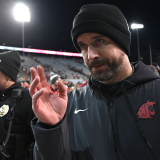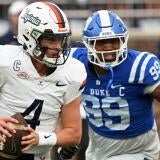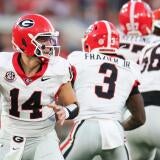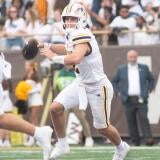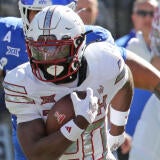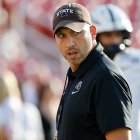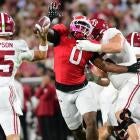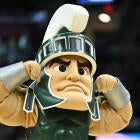Friday Five: Greatest college football running backs to fizzle out in the NFL
Just like with quarterbacks, being great in college doesn't mean a running back will be a great pro

Every Friday, the Friday Five will rank something in the world of college football -- anything and everything from the logical to the illogical. This week, we rank the five running backs who were great in college but couldn’t carry that success to the NFL.
The NFL Combine began earlier this week, but things really kicked off on Friday when players took to the field to begin running drills. The one player on the field during drills on the first day that everyone was paying attention to was former LSU running back Leonard Fournette.
While we don’t know how the NFL Draft will shake out, the common thought is that Fournette is likely to be the first running back taken in the draft, and that he could be a top-10 pick. It makes sense because, when he was healthy, Fournette was an absolute monster at LSU. He’s huge, and he’s just as capable of running you over as he is of running away from you.
He was a great college running back for a reason, but as we’ve seen many times, being great in college is no guarantee of a great NFL career. While the position where this is most obvious is quarterback, the truth is that we’ve seen a fair share of busts at the running back position.
I believe Leonard Fournette is going to be a good running back in the NFL, provided he can stay healthy, but the chance he’s a disappointment still remains. And that’s what inspired me for this week’s Friday Five. This week, I’m going to rank running backs who had great college careers, but couldn’t find that same level of success in the NFL.
We’ll start with a guy who left college as the sport’s all-time leading rusher.
5. Ron Dayne, Wisconsin: Now, when you compare Dayne’s college career to his NFL career, they weren’t even close. Dayne rushed for 7,125 yards in four seasons with the Badgers, going over 2,000 yards in both 1996 and 1999. He also won the Heisman Trophy as a senior in 1999, and was then selected 11th overall by the New York Giants in the first round of the 2000 NFL Draft.
And he never lived up to that spot.
He showed promise in his first two seasons in the NFL, but over the course of seven seasons with three different teams, Dayne finished with 3,722 yards and 28 touchdowns while averaging only 3.8 yards per carry. Compare that to his senior season at Wisconsin when he rushed for 2,034 yards and 20 touchdowns while averaging 6.0 yards per carry.
Still, even if he was a disappointment overall, I can’t put Dayne any higher than fifth on this list because he still played in the league for seven years. He had a career, just not the career he or the Giants were expecting.
4. Curtis Enis, Penn State: In the interest of full disclosure, being a fan of the Chicago Bears (no, I don’t know why I would be, either), this one could be a bit personal for me. You see, Curtis Enis had a solid career at Penn State, though I don’t think many would call it spectacular. While he was a consensus All-American in 1997, he was never a Heisman finalist, nor did he win any major awards. This was not Enis’ fault, however, as he happened to be playing at Penn State at the same time as guys named Ron Dayne and Ricky Williams were running the ball at Wisconsin and Texas.
Enis had a very good career, though, as he compiled 3,079 total yards and 38 touchdowns over his final two seasons at Penn State. His mixture of size and speed made him an enticing enough draft prospect that the Bears took him with the fifth pick of the 1998 draft, just after guys like Peyton Manning and Charles Woodson, and ahead of guys like Fred Taylor and -- the biggest heartbreaker of all for this Bears fan -- Randy Moss.
It was a bad pick!
Enis only played in nine games as a rookie, rushing for 497 yards without any touchdowns on 133 carries. The next season, he rushed for 916 yards, which would seem promising if not for the fact he needed 287 carries (3.2 yards per) to get there, and only managed three touchdowns. Enis would then receive only 36 carries in 12 games in his third and final season in the NFL.
3. Toby Gerhart, Stanford: Gerhart didn’t have a great four-year career in college, but he really took off over his final two seasons at Stanford. Playing for Jim Harbaugh, Gerhart became a battering ram in the Stanford backfield and was the focal point of the offense, even with Andrew Luck on board during Toby’s senior season.
Over his last two years, Gerhart rushed for 3,007 yards and 43 touchdowns. His senior season was so strong that he finished second in 2009 Heisman voting, falling only 28 points behind Alabama’s Mark Ingram. He also received 222 first-place votes to Ingram’s 227, so it was a very close race.
Gerhart was taken in the second round (51st overall) of the NFL Draft by the Minnesota Vikings. It wasn’t the best situation for him, however, as the Vikings had some other guy named Adrian Peterson, and Gerhart was only going to be a backup from the start. The problem is he never performed well enough to earn more carries than he received, and when he finally got a chance to be a starter in Jacksonville, he flopped. In 21 games with the Jaguars, he rushed for only 370 yards and two touchdowns, averaging 3.1 yards per carry. He was released by the Jaguars and didn’t play for anybody during the 2016 season.
2. Montee Ball, Wisconsin: Our second Wisconsin running back to make the list, Montee Ball had a career similar to Ron Dayne’s in college, though he was smaller and with more burst. In four seasons with the Badgers, Ball managed 5,738 total yards and set an FBS record with 83 total touchdowns. While he didn’t win a Heisman, he did finish fourth in 2011. He also won the Doak Walker Award given to the best running back in college football in 2012.
As a result, the Denver Broncos decided to use a second round pick (58th overall) on Ball in 2013. As a rookie, he served as a backup to Knowshon Moreno and played well enough, rushing for 559 yards and four touchdowns. He showed enough promise that the Broncos let Moreno leave following the season with the intent to have Ball be their starter 2014.
And he was...for three games. Poor performance and injuries limited Ball to only 172 yards on 55 carries that season. He would be cut by the Broncos in 2015, and was signed by the New England Patriots, but never played for them and was ultimately released again. In 2016, Ball was sentenced to 60 days in prison after pleading guilty to domestic violence charges against him. While he’s still young -- given his struggles in Denver, and his problems off the field -- it’s safe to say Ball’s NFL career is already over.
1. Archie Griffin, Ohio State: This list wasn’t the easiest to put together, or rank, but I never had much trouble figuring out who would be at No. 1 when I was finished. Archie Griffin was a great player for Ohio State. To this day, he remains the only player in college football history to win the Heisman Trophy in consecutive seasons (1974, 1975).
In four seasons with the Buckeyes, Griffin rushed for 5,589 yards and 26 touchdowns, averaging 6.0 yards per carry. To this day, Griffin remains No. 8 on the all-time college football rushing list.
He was taken with the 24th pick of the 1976 NFL Draft by the Cincinnati Bengals, but he could just never find that same magic in the NFL.
He would play seven seasons with the Bengals, but never rush for more than 688 yards in any of them. By the time his NFL career came to an end, Griffin had rushed for only 2,808 yards and seven touchdowns. Not an awful career, but nothing close to what you’d expect from a guy who won consecutive Heisman Trophies.
Honorable Mention: LaMichael James, Oregon; Lawrence Phillips, Nebraska; Rashaan Salaam, Colorado; Trent Richardson, Alabama; Charles White, USC



